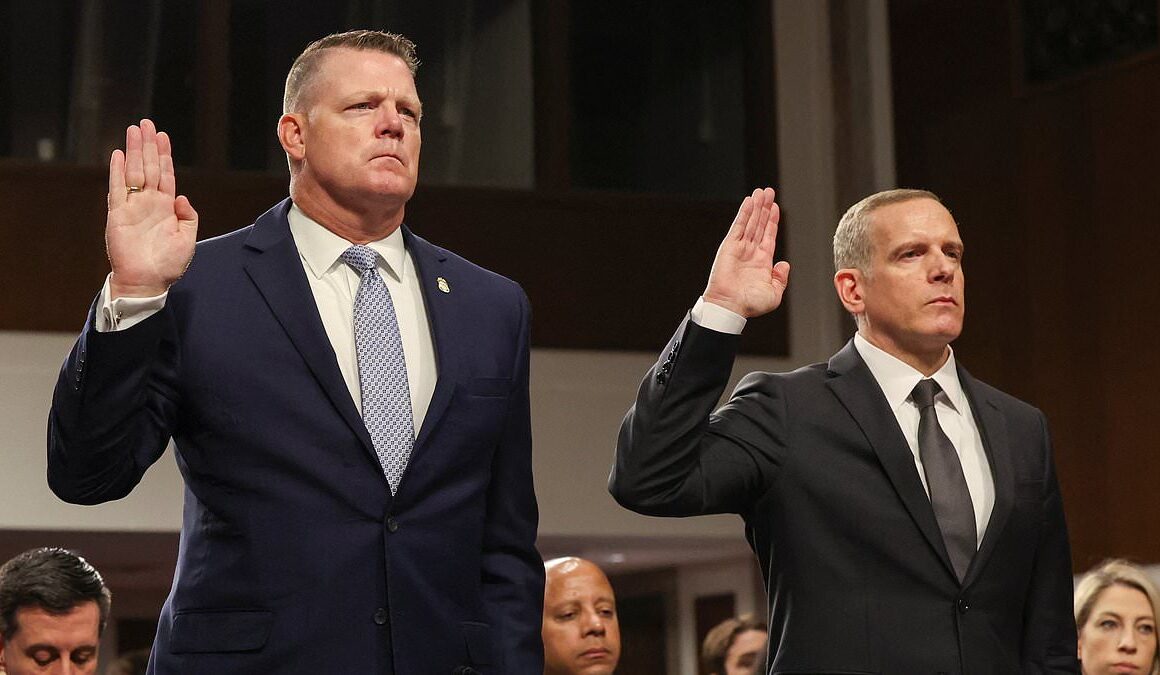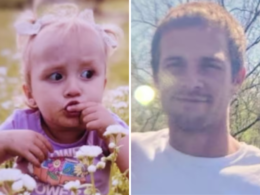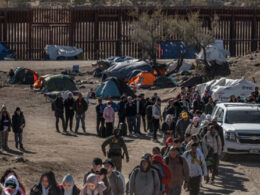The Secret Service’s now-top leader Ronald Rowe admitted he had no defense as for why the rooftop where Thomas Matthew Crooks fired shots toward former President Trump was left open.
‘I went to the roof of the AGR building where the assailant fired shots, and I laid in a prone position to evaluate his line of sight. What I saw made me ashamed as a career law enforcement officer and a 25 year veteran with the Secret Service. I cannot defend why that roof was not better secured,’ he told Congress on Tuesday.
Crooks fired eight rounds toward Trump, killing firefighter veteran Corey Comperatore, critically injuring two and grazing Trump with a bullet in his ear.
Acting Director Rowe and Deputy Secret Service Director Paul Abbate testified in a rare joint Senate hearing on Tuesday.
Thirty seconds before Crooks fired his shots, local law enforcement had radioed to Secret Service warning about a man with a rifle on the roof.

Acting Director Rowe and Deputy Secret Service Director Paul Abbate testified in a rare joint Senate hearing on Tuesday
Rowe said that since the shooting he’d implemented a number of changes at the Secret Service, including having security plans go through multiple supervisors before implementation, expanded use of drones, more resources for protective site communications and ‘expeditious’ approval of requests for personnel at protective sites with heightened security environments.
Rowe and Abbate spoke to the Judiciary and Homeland Security committees after their boss, former Secret Service Director Kimberly Cheatle submitted her resignation last week after a six-hour-long hearing where Republicans and Democrats accused her of stonewalling.
In his opening statement the Homeland Security Committee’s top Republican Rand Paul revealed that local law enforcement had told his office they’d warned the Secret Service about the vulnerabilities of the rooftop where Thomas Matthew Crooks fired shots at the president.
‘Local law enforcement told my staff that they specifically flagged the vulnerability of the building to the Secret Service, and were told that it would be taken care of. Clearly, these vulnerabilities were not addressed.’
On Monday new text messages revealed local law enforcement officers working former President Donald Trump’s Butler, Pennsylvania, rally were severely understaffed ahead of the attempted assassination.
During the tragic rally, Trump was shot in the ear and a former volunteer firefighter lost his life after 20-year-old Thomas Matthew Crooks opened fire from the roof of a nearby building just outside the security perimeter.
Bombshell new text messages between the Beaver County emergency services team from the days leading up to the rally show that there was a staffing shortage.
On July 8, five days before the rally, an unnamed team leader officer wrote in a text chat that they had been ‘requested by Butler to assist’ with Trump’s rally and needed six people to step up for the 12-hour detail. Two offered to do so for the whole time, and two more offered to split the Saturday shift.
The law enforcement leader wrote in the thread that he only had a few people available to work the event because ‘everyone else is either working, on vacation or hurt.’
The never-seen-before messages also lay out a timeline of nearly 90 minutes from between the identification of Crooks and his deadly fire.
New messages, bodycam footage and law enforcement debrief were obtained by Sen. Chuck Grassley, R-Iowa, who is conducting oversight of the event.
The messages showed that law enforcement were aware of Crooks, whom they spotted more than an hour and a half before Trump took the stage.
At 4:26 p.m., a Beaver County sniper finished his shift and departed the AGR building, where Crooks was able to access and take his shots from.
As the sniper left the building, he texted a chain about a suspicious person he’d spotted – which turned out to be Crooks.
‘Someone followed our lead and snuck in and parked by our cars just so you know,’ read one message.
‘I’m just letting you know because you see me go out with my rifle and put it in my car so he knows you guys are up there.’
The officer noted that he was sitting at a picnic table ‘about 50 yards from the exit.’
‘That bike was not there when I pulled out. Maybe have them check that car,’ they went on.
Later on, officers exchanged photos of Crooks, who had then been marked a ‘suspicious person,’ at 5:38 p.m., over 30 minutes before Trump was shot.



‘Kid learning (sic) around building we are in. I did see him with a range finder looking towards stage. FYI. If you wanna notify SS snipers to look out.
Another officer asked what direction Crooks was headed, to which an unnamed officer replied, ‘if I had to guess toward the back. Away from the event.’
It comes after a whistleblower last week revealed Secret Service stood in the way of using drone technology to survey the scene of the Butler rally where an assassin tried to shoot former President Donald Trump.
Sen. Josh Hawley, R-Mo., revealed last week that one whistleblower had told his office the night before the rally Secret Service ‘repeatedly denied offers from a local law enforcement partner to utilize drone technology to secure the rally.’
The whistleblower alleged that after the shooting Secret Service ‘changed course and asked the local partner to deploy the drone technology to surveil the site in the aftermath.’






